
100 Bay Street
Sausalito, CA, US, 94965
Tel:415-331-6200
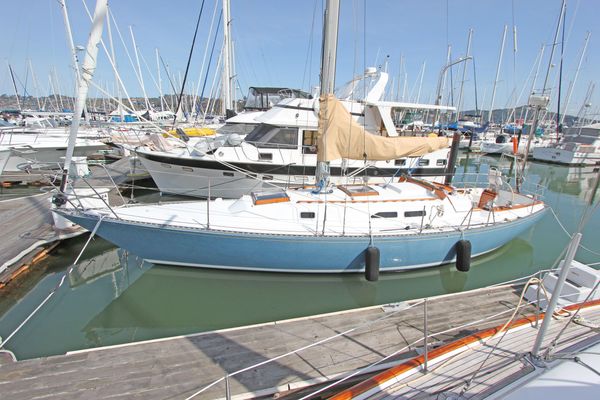
1977 Newport C&C 41S
The Newport 41, born of the successful C&C Redline CCA racing design and continuously built by Capital Yachts between the mid 1970's and early 1990's, proved both a successful racer and fast cruiser and while it's becoming harder and harder to find a nice example, they've remained very popular on the brokerage market--as Practical Sailor puts it, "The N-41 makes an excellent case for the fact that a boat that was designed intelligently and built well in the first place has a good chance of standing the tests of time."
In that November 2019 article reviewing the design, Practical Sailor described the boat as "tough, fast and sea-kindly offshore". They went on to say ..."the Newport 41 is at her best upwind in a breeze. She tacks through 80 degrees and stands up well under full sail, chomping along on her sailing lines at about 25 degrees of heel; she stands church-like until the breeze gets near 20 apparent, without the need for a reef (she also has a deep, secure cockpit, all of which is PERFECT for typical Bay conditions!)."
"Balance, maneuverability, and seakindliness are other areas in which the N-41 deserves high marks. “Sports car” steering comes from her deep rudder, self-tending ease on the helm comes from her long, even lines and gradually faired sections, the heft and solidity of a deep, heavy boat make her motion something that sailors of all kinds can appreciate, and the bullet proof solid fiberglass hull (an inch thick at the bilge) and balsa/fiberglass cored deck provides a sturdy surround for an interior that's a cozy, practical and liveable option for a cruising couple whose concerns are more about good sailing performance and safety."
So the Newport 41 is a great design, and Princepessia (hull no. 73), first bought at the Rhode Island Boat Show and spending her first 30 years or so back east, is a great example--with the same long term owners since 2010 and Awlgripped from the waterline up, today she shows MUCH newer than her actual age. Note repowered with a Yanmar diesel in the mid/late 1980s (and less than a thousand total hours clocked since!), new Hood mainsail in 2011 (standing and running rigging replaced in 2003), new interior cushions and curtains in 2013, new three-bladed Max Prop in 2013, new lifelines in 2014, new Hood jib in 2015, new exterior canvas in 2017 covering beautiful brightwork, new Harken roller furler in 2019, last hauled in late 2021 (the bottom was painted and decks Awlgripped in Signal White, this was a $36,000 haul out!), engine serviced in 2022, much more.
Also note she's lying in a potentially transferable downtown Sausalito Yacht Harbor slip; there's a long wait to get into the marina here so this is a material benefit if you're able to take advantage.
Specifications
Engine 1 Specifications
Media Gallery
 |
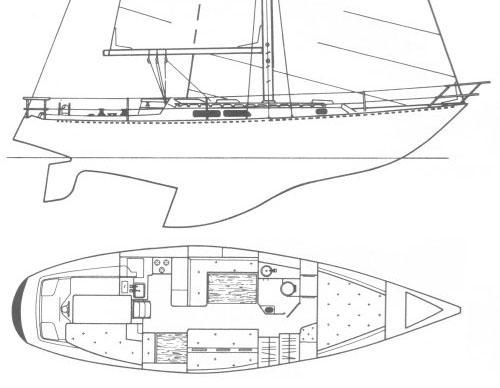 |
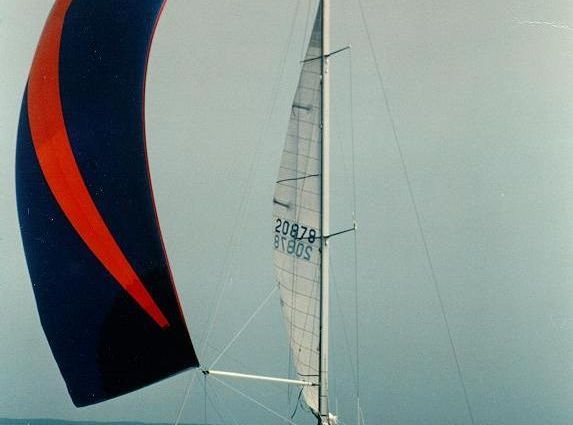 |
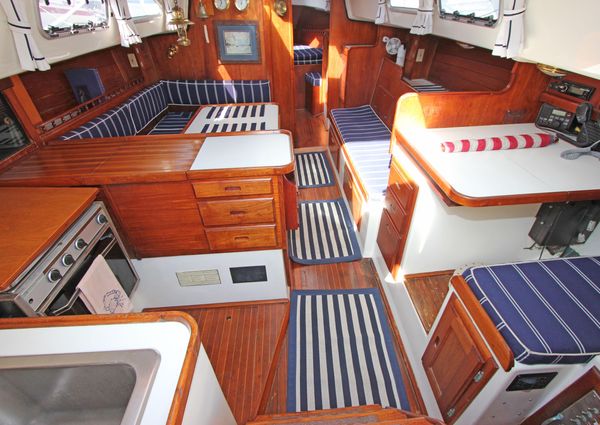 |
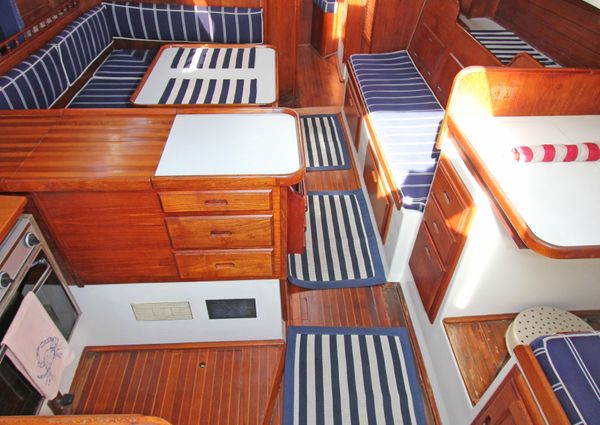 |
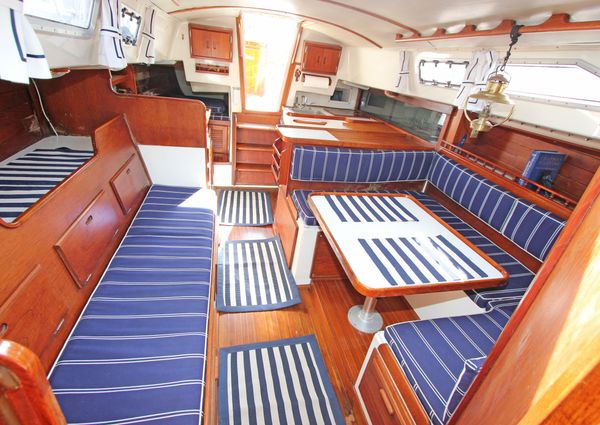 |
 |
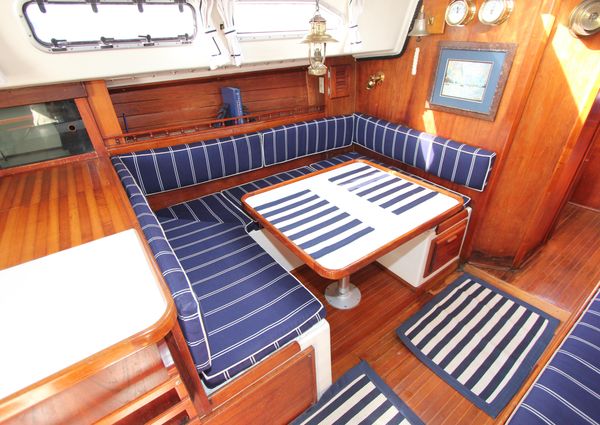 |
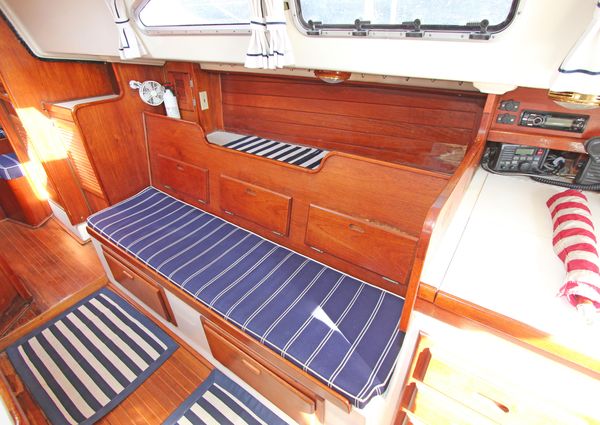 |
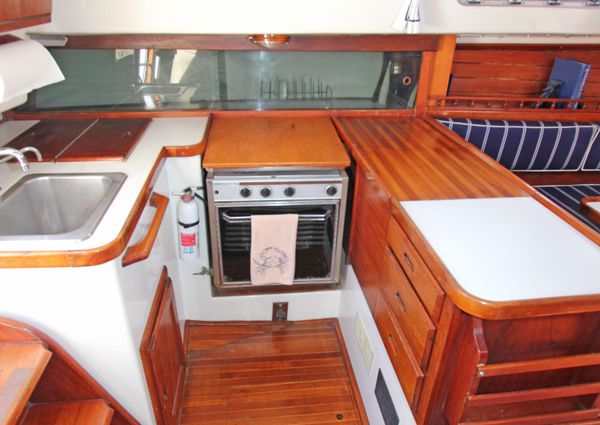 |
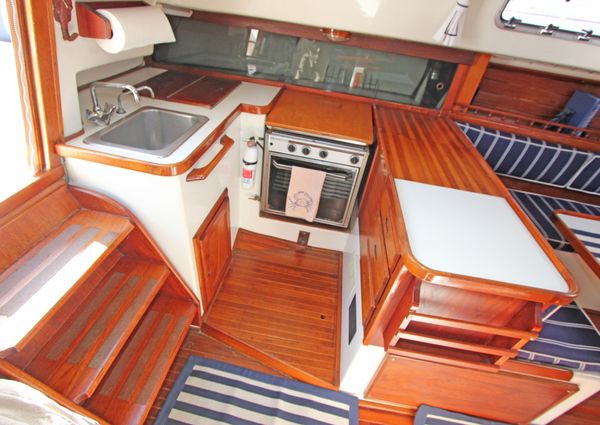 |
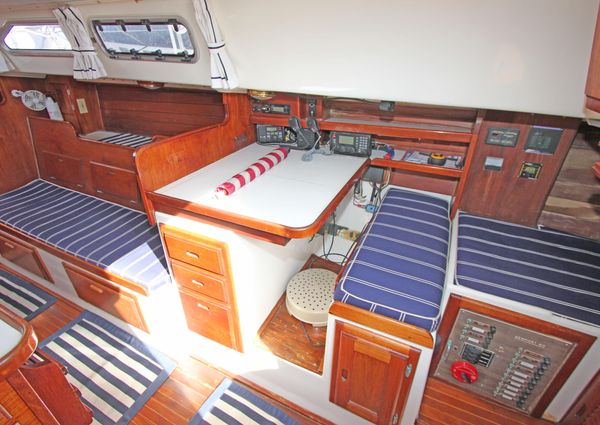 |
 |
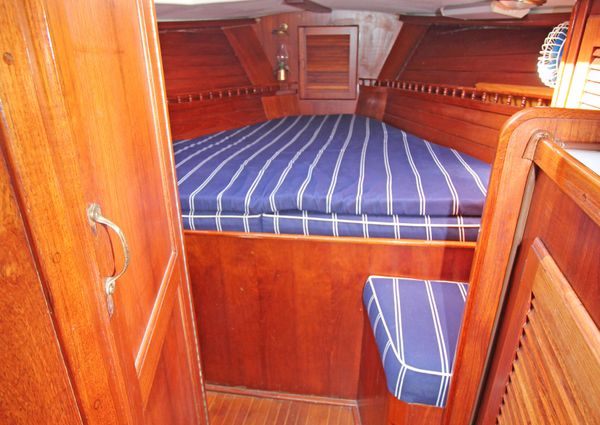 |
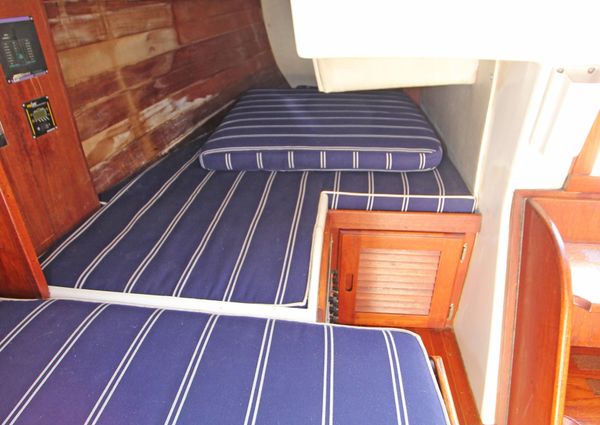 |
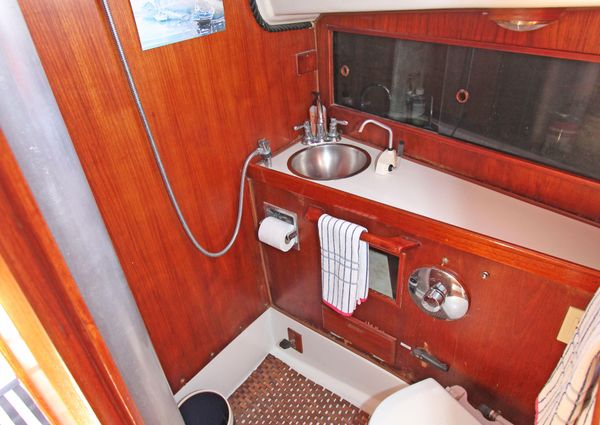 |
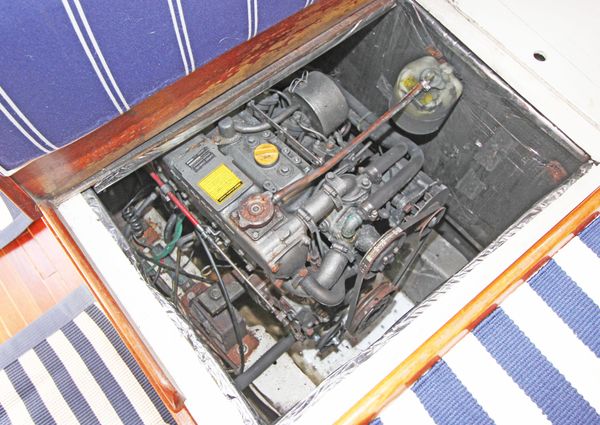 |
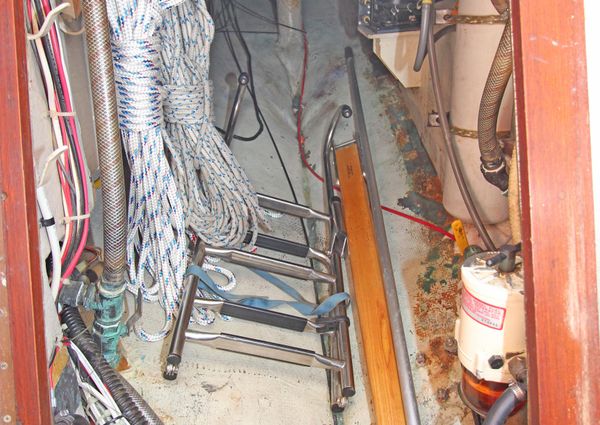 |
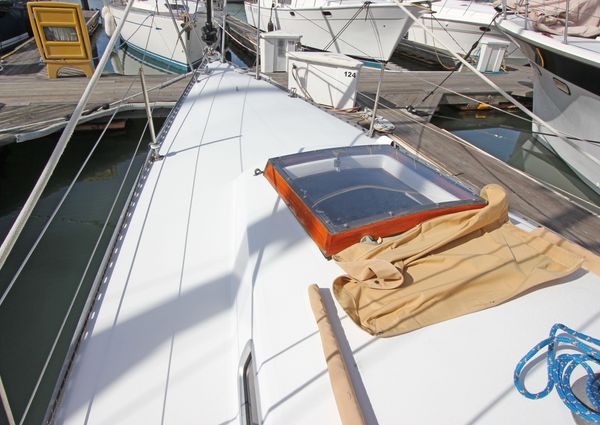 |
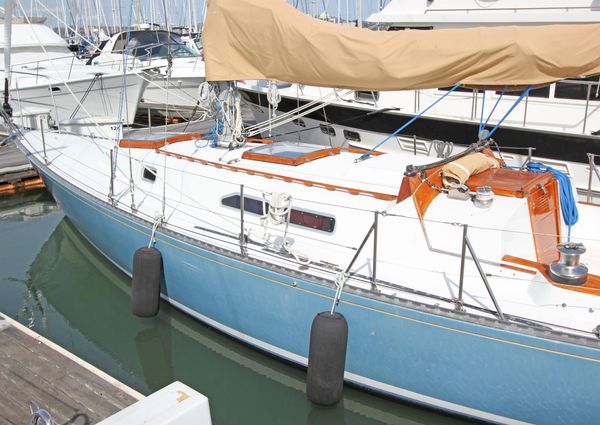 |
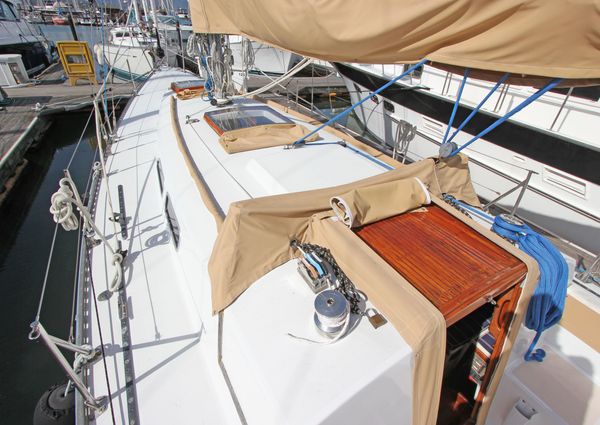 |
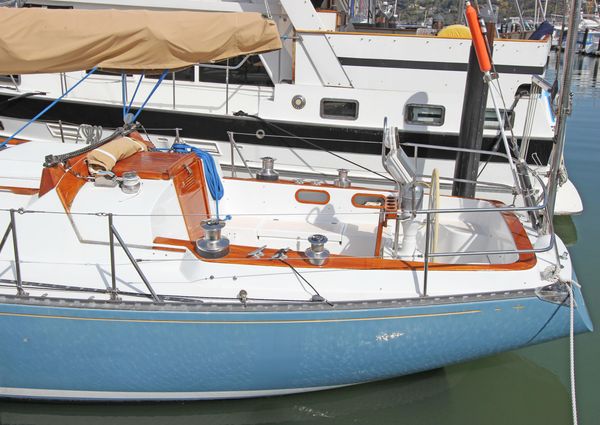 |
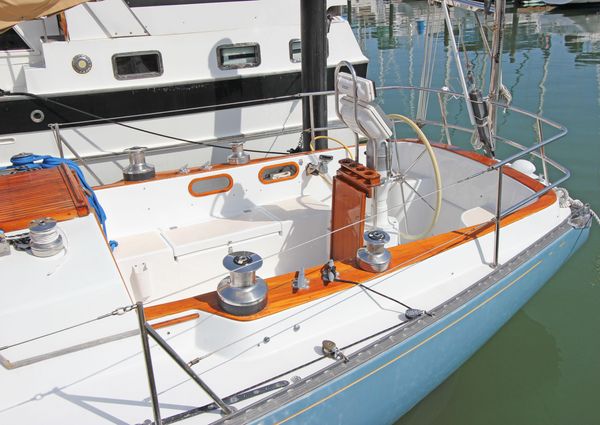 |
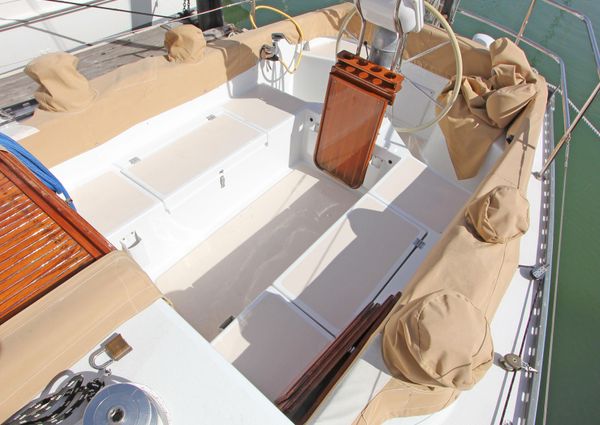 |
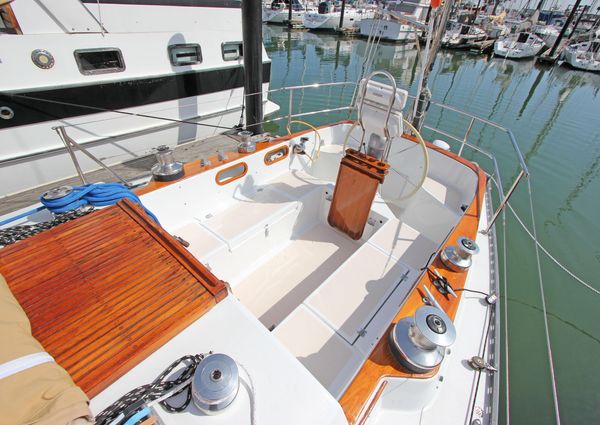 |
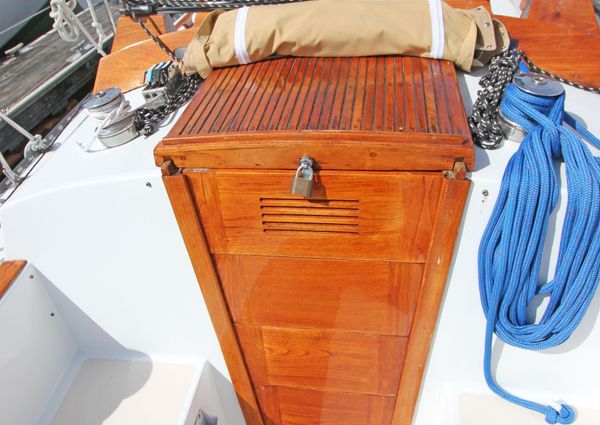 |
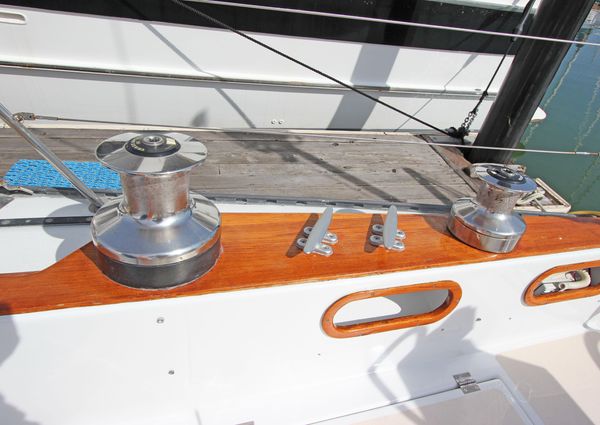 |
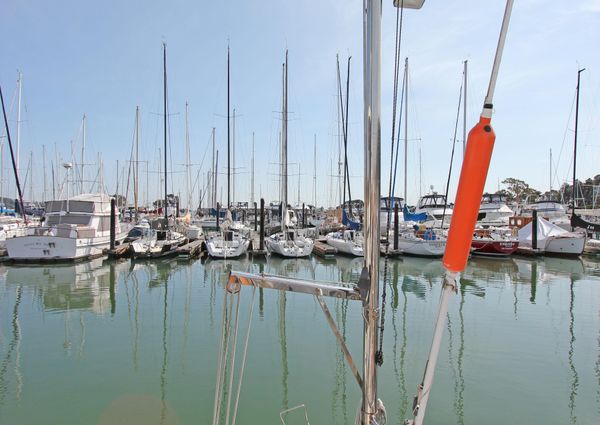 |
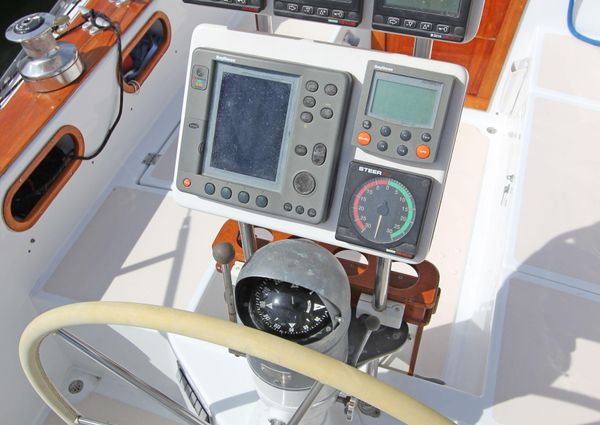 |
Forward stateroom with BIG double berth and ensuite head with shower, step aft and down a half step to salon with C shaped dinette (which drops down to make a double berth) port side with straight settee and pilot berth across to starboard.
Continue aft to L shaped slightly raised galley port side, centerline companionwa, and nav station across to starboard with quater berth far aft.
Note new interior cushions and curtains in 2013; tastefully done in dark blue and white, they contrast beautifully against the teak joinery! 6'1 headroom.
Large U shaped galley with lots of storage, hot/cold running water at stainless steel deep sink, Kenyon gimballed three propane burner stove with oven, oversized ice box with Adler Barbour 12V refrigeration.
Head with separate stall shower and Bemis manual pump marine toilet with new macerator pump, hoses and Y valve (2016) for holding tank.
110V AC / 12V DC. Thirty amp shore power service with new shore power cord in 2020, three Group 29 batteries (2018) in two banks with parallel switch, TrueCharge 20 amp battery charger. Note DC system was overhauled prior to current owner's purchase, date unknown.
Raytheon RL70C Pathfiner charplotter/radar (2001), Raytheon ST6000+ autopilot, Nexus wind speed/direction, Nexus depth sounder, Icom IC-502 VHF radio with external speaker (2002), West Marine clock, West Marine barometer, Ritchie magnetic compass at helm.
B&G electronic multi display (wind speed/direction, depth) new in boax, not installed.
Sony CDX-805 AM/FM/CD stereo with Bose speakers below and in cockpit.
Heavily laid up FRP hull (1" thick fiberglass thru the bilge area!) with balsa-cored decks and marine plywood for extra stiffness at the edges of the deck, and in spots where hardware is attached, for extra stiffness with the deck dropped onto an inward-turning flange in the hull; that joint is then bedded with sealant and mechanically fastened with bolts on 4″ centers with the resulting seam then sealed with the signature C & C aluminum toerail with cutouts. Swept back "shark fin" keel with lead ballast, semi skeg-hung rudder.
The hull was Awlgripped in Stars & Stripes Blue in 2013, with the decks and cockpit Awlgripped in Cloud White in 2021; KKMI did a beautiful job that really must be seen to be appreciated.
Stainless steel bow and stern pulpits, heavy duty stainless steel stanchions with double lifelines installed in 2014 (and these are the cool ones without the white vinyl covering!), polished stainless steel radar pole with outboard motor hoist.
Pepowered in the mid/late 1980s with a naturally aspirated three cylinder, four stroke Yanmar fresh water cooled diesel engine in in the mid/late 1980s, 951 total hours clocked since. 1 1/8" stainless steel shaft through bronze strut to three bladed Max Prop (2013, serviced in 2019).
Wheel steering via cable/quadrant system, nice Yacht Specialties pedestal with Navpod for navigation instruments (and the wheel has a new elkskin cover which makes a huge difference in terms of comfort for the helmsman!).
Double spreader keel-stepped aluminum mast with 1x19 stainless steel standing rigging (renewed in 2003 along with running rigging, aluminum boom with Hood full batten mainsail (2011) and Navtec adjustable hydraulic backstay, Hood 100% jib (2015, with sun protector replaced in 2019) on Harken MK IV roller furler (2019), Harken mainsheet with traveller.
Two Lewmar #55 three-speed winches, two Lewmar #44 three-speed winches, eight Lewmar #40 two-speed winches, single Barient #10 winch.
Sailors over the years have invested large sums and enlisted eminent designers in search of the “dual-purpose boat,” that rare craft that rewards her owner equally with racing performance and cruising capabilities. Season after season the major builders snatch up the rights to prize-winners, conduct focus groups, and expend marketing dollars on racer/cruisers, and cruiser/racers, in hopes of making the twain of racing and cruising meet. When we checked with owners of the venerable Newport 41, we found her to be not only a widely traveled cruiser but a boat that, though designed in the ’60s, can still gather some silver on the PHRF and Beer Can circuits.
The surprise didn’t last long; the Newport 41 began life from the parent molds of the Redline 41 from Cuthbert & Cassian. In its heyday, C & C was one of the sport’s foremost builders of production racing boats. When she was designed in 1967, the Redline was queen of that C & C stable. Today’s boats have gotten longer on the waterline, shorter in the ends, wider in the beam, and flatter on the bottom. Fashion, technology, and function have all made them that way. So, too, have the rules under which they race. The N-41 is a good yardstick to measure the distance that boats have come.
The Redline 41 was designed to the CCA Rule (CCA stands for the Cruising Club of America). Those salts who were around at the time (and even some who have come along since) tend to romanticize that rating system as “open” in terms of the types of boat that it encouraged. It was criticized for rewarding beamy centerboarders like three-time Newport-Bermuda winner Finisterre, and even the good old days had their bad old rulebeaters… but today CCA boats are generally regarded as “healthy” boats. They were markedly heavier than the boats (IMS, IOR, et. al.) that have come since. They had narrow hull forms with smoother sectional shapes. The philosophy of “if it doesn’t break, it’s too heavy,” prevalent in today’s engineering of performance boats, had yet to take hold.
As the Redline 41, the boat was at the top of the heap in her day. Then C & C recouped its investment in her (making room at the top for the C & C 61) and sold the tooling to Enterprise Yachts of Santa Ana, CA. Their version of the boat was something of an “all things to all people” creation. Their ad copy emphasized that she had “several major series wins to her credit,” but went on to describe how she sleeps seven in comfort and luxury and is distinguished by an interior offering sumptuous standards of finish and function. And back then, in 1970, the complete boat sold for $29,995!
But Enterprise didn’t sell enough of them to make a go of it, and the molds for the 41 passed to Capital Yachts, Inc., an operation in Harbor City, CA, started by Bay area builder/sailor Jon Williams in late 1972. Capital added several inches of freeboard to the hull and put a greater accent on wood below, but the Newport 41 (as they introduced her) was still very much a boat that you could race, particularly offshore. With Capital’s additions, and time, by 1983 a nicely equipped boat cost $85,000.
For the next 14 years Capital turned out roughly a boat a month. This early racer/cruiser formed the backbone of a line that included several smaller boats. She continued to be built right up until 1993, when Capital closed its doors.
Design
C & C produced a startling variety of race-pointed designs over its three decades in business, but one hallmark of them all was minimum wetted surface. From easily driven swept-back keels through semicircular sectional shapes, smooth waterlines, and sweetly harmonized buttocks, the C & C hull shape was drawn to make a minimum of fuss as it passed through the water. Though decidedly heavier than the boats of today, and carrying a smaller, less efficient sailplan, the Newport 41 still has excellent “manners” because she’s so easily driven.
A key factor in that performance is her narrow 11’3″ beam (another design element that makes her easier to sail than some of her broader-beamed rivals). The hull is somewhat veed forward (owners report dry decks in seas up to three feet), regular and relatively tubular through the midsections, and tucked up slightly at the counter. The beam, however, is carried well aft for sail- carrying power and to provide an antidote to pitching. After 15 degrees of heel the counter adds a foot or more of waterline length and boosts the boat’s top-end speed potential. Sail carrying power also comes from full stern sections which explains why the boat’s best point competitively has been off the wind.
The Newport 41 is stiff. She tends to lie down onto her sailing lines and stay there. Credit that to her 8,215 pounds of ballast. That’s a lot of weight to be lugging. Some modern 40-footers don’t weigh that much altogether.
Toting all of that lead weight definitely limits the 41’s speed potential, especially with only 750 sq. ft. of rated sail area. The weight does some good things, too, though. The boat’s motion in a seaway is “old fashioned” and “substantial.” She doesn’t let the waves push her around. And she stands churchlike until the breeze gets near 20 apparent, without the need for a reef.
Accommodations
Expectations were different for offshore racers when the Newport 41 was born. It was thought that heads would have doors, that pipe racks belonged in outlet stores, and that a boat should offer sailors something solid to keep them safe from wind and wave.
Consequently, the N-41 is far from stripped out. Her cockpit is a good example of the thinking that went into offshore racers of her vintage. It’s big enough, the well is deep enough, and the functions are spread enough so that five or even six can race the boat with efficiency and space. On the other hand, the benches are long enough (67″) to rest on, if not stretch out. The helmsman’s area is separate enough to allow concentration, yet big enough for comfort.
One of the most unusual aspects of the boat’s interior is her offset engine. To reduce pitching (and to create a mega-locker in the space beneath the companionway) the inboard (originally gas but later standardized as a 35-hp. diesel) is tucked beneath the galley counter on the port side. This necessitates an off-center prop (whose drag would be lessened if it had some deadwood to hide behind) but it opens up that space below the shallow (three-step) companionway stairs. “I’ve got room for two inflatables in there, and maybe a few outboard motors, too,” brags one owner. Most owners rate the engine installation “better than average” for access and some have experimented with folding or feathering props to reduce the drag. Gains of 0.4 to 0.9 knots are reported.
Some owners rate their interiors “Chevrolet” for interior aesthetics. Others like what they have better than modern boats from the lower half of the price range. Several report that varnishing the teak below has brightened things up a lot. While the matched-grain precision of some of the high-priced boats isn’t evident, Capital is reported to have done an honest job of fit and finish that makes the boats quite pleasant places in which to live.
There are, of course, problems:
“The settee in the saloon is too small.” “The pointy end of the platform double is too narrow.” “We’ve had two fires on our alcohol stove.” “Ventilation is only fair.”
These are owner critiques of an interior that seems otherwise to do a good job of filling the bill. The nav station (starboard) and galley (port) are not only big, they’re placed for optimal communication abovedecks. The head to port, and hanging lockers to starboard form a nice divider separating the forecabin from the saloon, enhancing cruising privacy. There’s a quarterberth to starboard. One owner labels it “claustrophobic,” but as a combination catch-all and secure sea berth, quarterberths are the best. We’d love to see them make a comeback against “aft staterooms” on smaller boats touted as comfortable offshore boats. Some boats also have a pilot berth to starboard, in place of lockers—another snug bunk when underway and heeled over.
Construction
Inch-thick fiberglass through the bilge area made up for what the builders of the ’60s and ’70s lacked in sophisticated mastery of their materials. The boat is heavy because she is heavily built. You might, today, to overstate an extreme example, build a boat twice as strong that weighed half as much. However, these boats have been around since the ’60s—we’ll see in 40 years or so how boats being built today have fared.
“My wife and I frequently sail ours on 1000-mile cruises.” “Ours has been sailed to Hawaii.” “My boat has raced over 20,000 offshore miles.” “I do my own deliveries to Mexico and back. We’ve run into some tough stuff and racked up over 8,000 nautical miles.”
These testimonials are evidence that the old-fashioned technique of layering cloth, mat, and roving into a “brick outhouse” has produced some sturdy boats.
The decks are balsa-cored, but plywood is used extensively at the edges of the deck and in spots where hardware is attached. Sometimes not enough attention was paid to sealing the core. Several owners report having had to redo their decks, either in spots or entirely. Others report leaks around the chainplates. The hull/deck joint, however, appears to be have been done well. The deck is dropped onto an inward-turning flange in the hull. That joint is bedded with sealant and mechanically fastened with bolts on 4″ centers. That seam is then sealed with the signature C & C aluminum toerail.
“We’ve had our boat for six years without a single deck leak,” a San Diego sailor reports.
Performance
The Newport 41 is at her best upwind in a breeze. She tacks in 80 degrees and stands up well under full sail, chomping along on her sailing lines at about 25 degrees of heel. A cruising sailor who doesn’t race his 41 says, “When other boats have to power to weather, I can sail and enjoy it.”
As you might expect, she’s at her worst in winds under 10. In British Columbia, where drifting is a way of life, one owner reports that his 150% “balloon jib” is a good antidote.
Balance, maneuverability, and seakindliness are other areas in which the N-41 deserves high marks. “Sports car” steering comes from her deep rudder. Self-tending ease on the helm comes from her long, even lines and gradually faired sections. The heft and solidity of a deep, heavy boat make her motion something that sailors of all kinds can appreciate.
The standard offset propeller is less of a success. Not only is it a source of considerable parasitic drag under sail, but it makes the helm a hair-trigger proposition under power. “Backing is an experience,” said one owner. ” It’s best accomplished at higher speeds with ‘lock to lock’ adjustments.”
Those who have fitted feathering or folding pros enjoy less drag and better control in reverse.
Owners say the engine will push the boat up to and over seven knots.
Conclusions
The N-41 makes an excellent case for the fact that a boat that was designed intelligently and built well in the first place has a good chance of standing the tests of time.
One evidence of the thoroughness with which this boat was built and supported is the owner’s manual supplied by Capital Yachts—a manual to put others to shame. It attempts, and in fact mostly succeeds, in instructing a new owner not only about the construction and fittings of boat, down to fairly minute detail, but what to carry in her, how to tune and sail her, and more. We downloaded the old manual to get details about the boat, and ended up reading large sections of it. It’s a conscientious gift of experience from builder to buyer.
Speed and maneuverability are significant virtues in a cruising boat, and the N-41 has retained them. Sailors who enjoy racing but are less happy about the expense, discomfort, and “to the edge” design of today’s racing boats will find the Newport 41 to their liking.
Practical Sailor, November 6, 2019, Darrell Nicholson
The Company offers the details of this vessel in good faith but cannot guarantee or warrant the accuracy of this information nor warrant the condition of the vessel. A buyer should instruct his agents, or his surveyors, to investigate such details as the buyer desires validated. This vessel is offered subject to prior sale, price change, or withdrawal without notice.